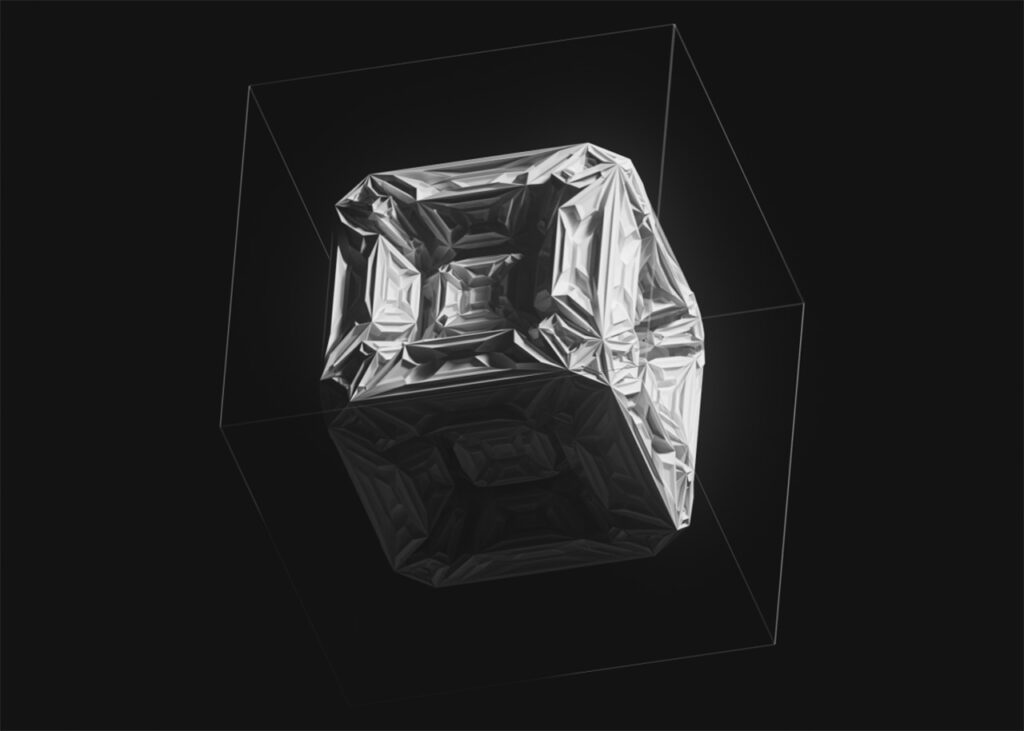An anonymous artist working in a non-conventional medium sells for astronomical prices at auction. If this formula sounds familiar in the current NFT bullrush, its modern progenitor is surely Banksy, an artist whose most enduring legacy is that today, street art’s social and financial value isn’t contentious, but commonplace.
Fitting, then, that the artist who so provocatively arrived on the auction block more than a decade ago has been paired with a disruptor of the financial industry, cryptocurrency. Through a collaboration with Coinbase Commerce, Sotheby’s will accept bitcoin or Ether for Banksy’s 2003 work, “Love is in the Air,” in a May 12 sale.
It’s the first time a major auction house will accept cryptocurrency for a physical work — love, one might say, is in the ether, or for the cynically minded, Ether is in the ether.

“The Cube,” part of Pak’s Fungible Collection, which was released on Nifty Gateway in a collaboration with Sotheby’s. Image: Sotheby’s
For the general public, NFTs and crypto art are expanding the possibilities and promise of art. For auction houses, feverish and lucrative NFT sales are expanding the pool of potential collectors by making first contact with previously untapped cryptocurrency holders.
Consider the following: in the first 10 minutes of Christie’s Beeple auction in March, 20 bidders sent the price from $100 to $1 million; only three of these bidders were known to the auction house. In Sotheby’s Pak auction the following month, more than 3,000 unique collectors took part and the vast majority of these were first-time buyers.
The globe’s leading auction houses have availed themselves to crypto-enthusiasts in these sales not only by accepting cryptocurrency and endorsing NFTs as an asset class, but by selecting two creators in Beeple and Pak that have long and strong roots within the crypto art scene. Collectors, for their part, have willingly opened digital wallets to acquire NFTs perceived as historic and to flex community status in the process.

CryptoPunks 58, 603 and 768, part of nine works featured in Larva Labs’ May 11 single lot sale at Christie’s. Image: Christie’s
This momentum will continue through carefully selected NFT sales, such as Christie’s upcoming CryptoPunks auction. The next logical step for auction houses is to grow these crypto and digital art communities into collectors of physical art. And in this light, a landmark Banksy work makes sense. Bold, irreverent, anti-elitist, and playfully trollish, Banksy’s work and secretive persona mesh neatly with the value of the crypto community, as Stefan Pepe, Sotheby’s Chief Product & Technology Officer, discusses with Jing Culture & Commerce.
Could you detail Sotheby’s approach to welcoming in new collectors from the world of crypto?
Our debut NFT sale with the crypto designer-native artist Pak had participation from more than 3,000 unique collectors, the majority of whom were first-time buyers with Sotheby’s. The decision to hold that sale as well as now accept cryptocurrency via Coinbase Commerce marks an important next step for the company as it aims to welcome new collectors from the world of crypto. Leveraging the trusted exchange Coinbase is a natural progression and is in line with our dedication to enhancing our client buying experience and developing new ways to expand our client base by meeting them where they are.
Is the decision to accept bitcoin/Ether for the Banksy work a direct reaction to recent events, or something long-planned?
Sotheby’s worked with the consignor of the painting to offer this new payment option for Banksy’s “Love is in the Air” given the artist’s history as the preeminent disruptor of the art world, paired with cryptocurrency as the leading disruptor in finance. Sotheby’s collaboration with Coinbase speaks to this relationship and to the growing adoption of cryptocurrency across personal and commercial financial applications.
Is this collaboration with Coinbase something we can expect for future physical sales? Longer-term, would Sotheby’s consider hosting its own infrastructure to accept cryptocurrency?
Following Sotheby’s first foray into crypto art and NFTs with the Pak sale in April, as well as the broader adaptations in the art market since the pandemic began more than a year ago, there is a growing need to create more flexible sale opportunities for clients to meet them where market demand is. By making Banksy’s “Love is in the Air” available for purchase with cryptocurrency, Sotheby’s continues its efforts to expand the current art market and provide new and innovative options to clients to transact in the market.
Does Sotheby’s have any intention now or in the future of holding the cryptocurrency it receives through auction (rather than converting to fiat currency)?
For the Banksy, the consignor has agreed to accept cryptocurrency as payment so we would facilitate that transaction like we normally would.



